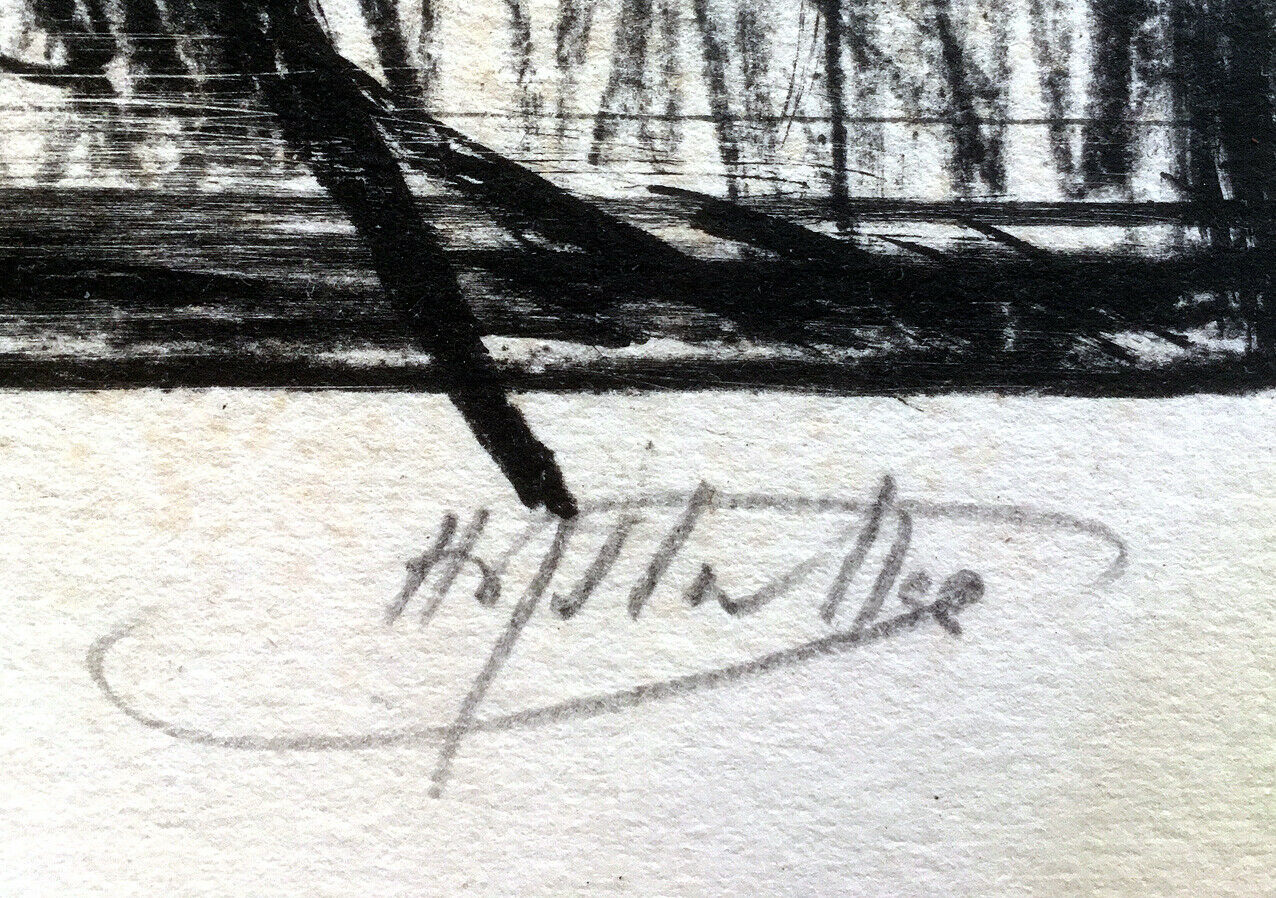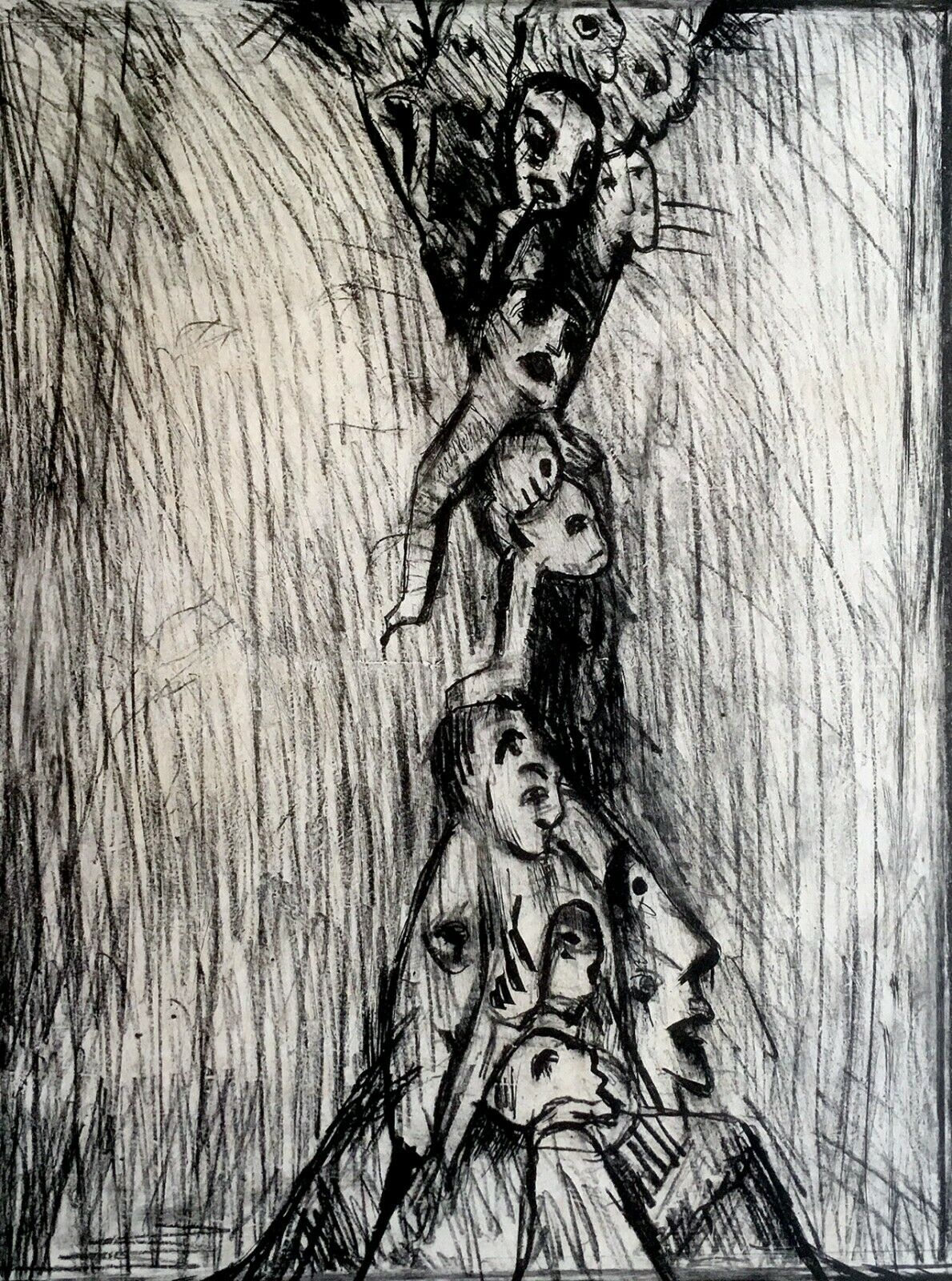-40%
HOFSTATTER Original SIGNED NUMBERED Art LITHOGRAPH Horrors HOLOCAUST Jewish
$ 50.16
- Description
- Size Guide
Description
DESCRIPTION:
Here for sale is an ORIGINAL hand SIGNED , LIMITED and NUMBERED ( 5/75 ) LITHOGRAPHIC piece by the acclaimed Israeli artist of Polish-descent , The beloved and most admired painter , The HOLOCAUST SURVIVOR whose art is deeply connected to the HOLOCAUST human suffering - OSIAS HOFSTATTER. Depicting a HORRIFYING , DISASTEROUS scene , Involving UNCLEAR FIGURES ( Children ? ) in GREAT AGONY .
The LITHOGRAPH is
HAND SIGNED and NUMBERED 5/75 by HOFSTATTER with pencil in LATIN LETTERS. LIMITED EDITION of only 75 copies . Size is around 18
x 12.5 " ( Not accurate ) . Pasted on cardboard as issued . Very good condition.
( Pls look at scan for accurate AS IS images )
. The piece will be sent in a special protective rigid sealed packaging .
AUTHENTICITY
: This is an ORIGINAL vintage hand signed LITHOGRAPH , NOT a reproduction or a reprint , It holds life long GUARANTEE for its AUTHENTICITY and ORIGINALITY.
PAYMENTS
: P
ayment method accepted : Paypal .
SHIPPMENT
:
Shipp worldwide via registered airmail is $ 25 .
Will be sent in a special protective rigid sealed packaging.
Handling around 5 days after payment.
Osias Hofstätter "Be faithful to your duty. Not only for your own good, so that there will be a memory, if only a tiny one…." Osias Hofstatter, Paintings, Massada, 1989, p. 88 Born in Bochnia, Austro-Hungarian Empire, in 1905. Died in Ramat-Gan, Israel, 1994. Following World War I, Hofstätter's family moved from Galicia to Vienna, then to Amsterdam and eventually to Frankfurt. In 1921, the family returned to Vienna, where they settled permanently. Hofstätter worked as a salesman. In 1938, after the Anschluss, the Gestapo arrested his parents. Osias along with his brother and sister managed to escape, to separate destinations. Ben-Zion and Fradl, his parents, were deported to the Lodz Ghetto, where they were murdered in June 1942. Osias escaped to Belgium, where he was reunited with his fiancée, Anna Schebestova; they married in Brussels in November 1938. In 1939, due to severe financial difficulties, they moved to the Marneffe refugee camp, established by the local committee for Jewish refugees in Belgium. After Belgium's capitulation in May 1940, Hofstätter was arrested and transported to the St. Cyprien Camp in southern France, and from there to the Gurs Camp. Thanks to efforts made by his siblings, who had escaped to Switzerland, Hofstätter was released and escaped to Switzerland via the Alps in 1942. He was arrested by the Swiss border police, and transferred to a refugee camp. In 1943, with the help of the Unitarian Service Committee, he was released in order to attend an art school in Zürich. A year after the end of the war, Hofstätter returned to Vienna, where he was reunited with his wife, and completed his studies at the Academy of Applied Arts. The couple moved to Warsaw in 1948, and immigrated to Israel in 1957. Although he gained recognition relatively late, his works were displayed in numerous exhibitions in Israel and abroad. Throughout his incarceration in the various camps, Hofstätter focused on portraiture. While at Gurs, his sister sent him crayons and small sums of money, enabling him to buy art supplies. The portraits on display depict the despair and depression of his fellow inmates. These figurative portraits reflect the initial stage of Hofstätter's artistic career, before he developed his unique expressive style echoing his personal trauma as a survivor of the Holocaust. Osias Hoffstatter View exhibitions » View videos and articles » Visit our Information Center to browse the artist file » File includes: 181 Articles 41 Exhibition invitations 156 Artwork reproductions Osias Hoffstatter, born 1905, Poland. 1938 Emigrated to Belgium, then escaped to Switzerland and began drawing. 1948 Returned to Warsaw as art editor of a weekly paper. Immigrated to Israel 1959. He established a new technique,after drawing or painting in balck ink, of scratching the paper to produce new art in the 1960's. Died 1994. Education 1919-20 Frankfurt School of Science, Germany 1946 Art Academy in Vienna, Austria Teaching Art in Poland. Awards And Prizes 1976 Dizengoff Prize for Painting and Sculpture, Municipality of Tel Aviv-Jaffa 1991 Bank Discount Prize for an Israeli Artist, Tel Aviv Museum of Art 1991 Sussman Prize for Artists Depicting the Holocaust, Yad Vashem, Jerusalem 1991 Danziger Prize, Jerusalem Osias Hofstatter was born in 1905 in Poland. In 1938, Hofstatter emigrated to Belgium, then escaped to Switzerland and began drawing. In 1948, Hofstatter returned to Warsaw as an art editor of a weekly paper. From 1942-46, Osias Hofstatter studied at the Art Schools in Zurich and Vienna. Hofstatter taught art in Poland. In 1976, Hofstatter was awarded The Dizengoff Prize for Painting and Sculptor Prize, Municipality of Tel Aviv Jaffa, Tel Aviv. Osias Hofstatter Born in Galicia, Poland. His father, Ben Zion, was a merchant and his mother was a housewife. In 1914, with the break of World War one his family moved to Vienna and later on continued to Haag and Frankfurt. Between the years 1919- 1920 Hofstatter attended the Frankfurt Science School. Eventually the family returned to Vienna in 1921 and stayed there until 1938. In Vienna Osias worked as an accounted. In 1938 Hofstatter parents was caught by the Gastapo and were sent the Dachau concentration camp. He and his brothers managed to escape and they migrated to Belgium while his fiancée Ana fled to Czechoslovakia. In 1940, Osais and Ana were reunited in Brussels and they married. A month after the marriage Osais was sent to a concentration camp in France after being accused in spying in favor of Germany. His wife was sent to a different concentration camp where she worked as a seamstress. In 1942 he managed to reach to Switzerland with the help of his brothers who arrived before him. In Switzerland he worked in a refugee camp and begin drawing. In 1943, Hofstatter sent some of his drawing to the United Nations Service Committee in Geneva that decided to let him attend an art school. Between the years 1942-1946 he attended art schools both in Zurich and Vienna. After the war ended he received a visa to Vienna and he came back to his wife. In 1948 the couple moved to Poland and settled in Warsaw, where Osais worked as an art editor of a weekly paper and an art teacher. In 1959 they migrated to Israel. They settled down in Holon and Osias worked as a night watchman. In 1970 he quitted his job and bought a small house near Natanya, where he dedicated his life to his art. During his lifetime, Hofstatter created over 5000 paintings and drawings, mainly in black ink. In the 60’s he established a new technique of scratching the paper. Most of his works where created after he left his job in 1970. At the same period he begun to build a reputation for himself as an artist. Osais and Ana had no children and after his death in 1994 all his works were given to the Herzelia Museum of Art. In 1976, Hofstatter won the “Meir Dizingoff” prize in Tel Aviv and in 1991 he were given the “Discount Bank Prize” for an Israeli artist. “I do not have many dreams, my dreams are my paintings, although I do not know what is going to be in a painting. My dreams a very rare and not significant, I dream that I am alive and it is sufficient for me”. Hofsatter, 1990.... Osias Hofstatter was nine years old when he was constrained to begin his wanderings. At the outbreak of the Second World War, he was thirty-five, a man in the prime of his life who had no yet made a home for himself, and was not yet an artist. With hundreds of others he was imprisoned in closed camps, and became a prisoner. Paradoxically, this was when Hofstatter began doing his first drawings: portraits, faces of fellow-inmates in a remand camp or a refugee camp, one of many. It is as if not only a way of life was imposed upon him there, but also his art. EBAY3698


















